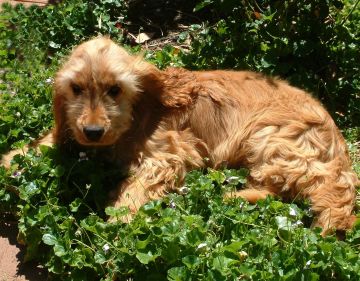Week 4: Pets in the garden
Gardens and pets don't always mix happily. In
fact, dogs have occasionally been described as
the 'only garden pest to be successfully
domesticated'.

With a bit of extra care,
however, pets, gardens and gardeners can live
in harmony.
Here are some of the most
common questions
asked of Yates garden advisers:
Q. I've used
hose-on Weed 'n' Feed on my
lawn. How long do I have to wait before I let my
dogs outside?
A. As soon as the grass is dry, the dogs can go
onto the lawn. Discourage them from eating
treated grass during the first week. After that
week, even grazing animals can be allowed
back on the grass but it's best to mow first.
Q. What about insecticide
sprays? How
dangerous are they to dogs and cats?
A. Always choose the least toxic spray that will
do the job. For example, Confidor is of low
toxicity and is long-lasting within the plant. And,
because Confidor remains active for such a
long time it doesn't have to be applied very
often. It also doesn't affect beneficial insects
such as ladybirds. Other low toxic insecticide
choices are pyrethrum, Nature's Way Insect
Spray, and spraying oils like Conqueror Oil.
Even with these low toxic suggestions, it's wise
to keep pets confined while the sprayed foliage
dries.
Q. How careful
do I have to be with Roundup
and other glyphosate sprays?
A. Zero and other glyphosate weedkillers are
low toxic and are of minimal danger to animals
but, once again, it's wise to keep pets away
until the herbicide dries (mostly because this
prevents the
pet from walking wet herbicide
onto desirable plants).
Pet-safe snail and slug control
Pet owners are wary of using snail and slug
pellets.
These days virtually all snail
pellets have an
added bittering agent that makes them taste
bad to mammals, but doesn't affect their
attractiveness to snails and slugs. However,
some dogs eat so quickly they don't give
themselves the opportunity to register the bitter
taste, and they can swallow a whole packet in a
few gulps.
So here some sensible suggestions
for using
snail pellets with care:
1. Spread pellets thinly,
according to
directions. Don't heap them. Heaping
pellets makes it easier for pets to ingest
harmful amounts.
2. Keep the packet away from pets, and
store it safely.
3. Watch the pet carefully after pellets
have been distributed. If the dog shows
any sign of eating pellets, remove the
pet and clean up the pellets. If in doubt,
contact your vet.
4. Place pellets inside a pet-safe pellet
holder.
5. Use Yates Blitzem Granules instead of
pellets. These tiny, dolomite-based
chips aren't attractive to pets but provide
long-lasting control of snails and slugs.
 Week
1 | Week 2
| Week 3 | Week
4| Product of the Month | Seed
of the Month
Week
1 | Week 2
| Week 3 | Week
4| Product of the Month | Seed
of the Month